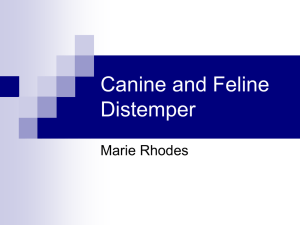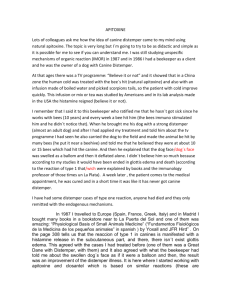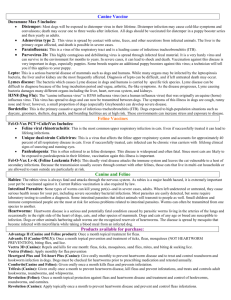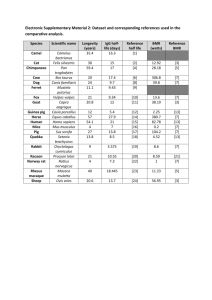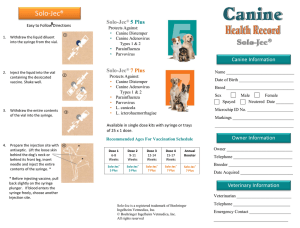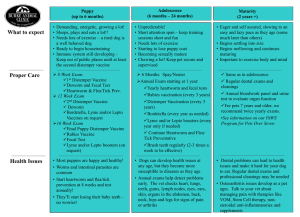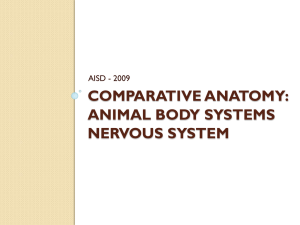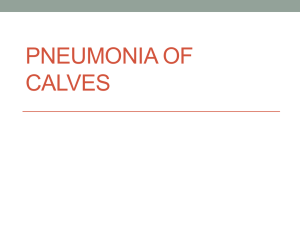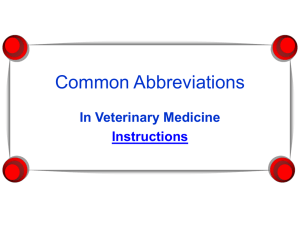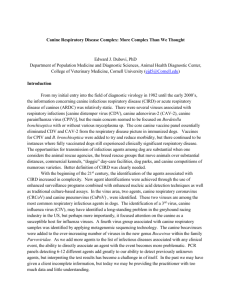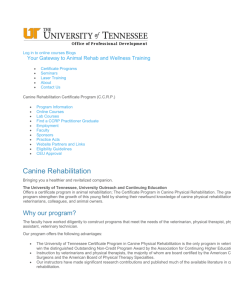canine_distemper
advertisement
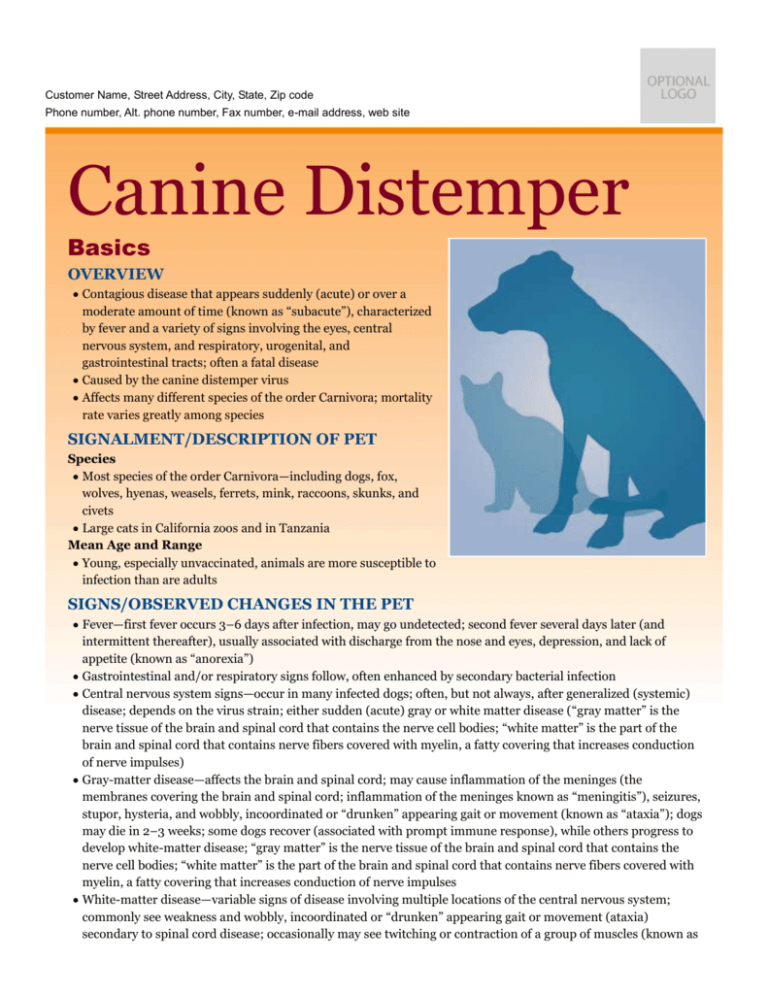
Customer Name, Street Address, City, State, Zip code Phone number, Alt. phone number, Fax number, e-mail address, web site Canine Distemper Basics OVERVIEW • Contagious disease that appears suddenly (acute) or over a moderate amount of time (known as “subacute”), characterized by fever and a variety of signs involving the eyes, central nervous system, and respiratory, urogenital, and gastrointestinal tracts; often a fatal disease • Caused by the canine distemper virus • Affects many different species of the order Carnivora; mortality rate varies greatly among species SIGNALMENT/DESCRIPTION OF PET Species • Most species of the order Carnivora—including dogs, fox, wolves, hyenas, weasels, ferrets, mink, raccoons, skunks, and civets • Large cats in California zoos and in Tanzania Mean Age and Range • Young, especially unvaccinated, animals are more susceptible to infection than are adults SIGNS/OBSERVED CHANGES IN THE PET • Fever—first fever occurs 3–6 days after infection, may go undetected; second fever several days later (and intermittent thereafter), usually associated with discharge from the nose and eyes, depression, and lack of appetite (known as “anorexia”) • Gastrointestinal and/or respiratory signs follow, often enhanced by secondary bacterial infection • Central nervous system signs—occur in many infected dogs; often, but not always, after generalized (systemic) disease; depends on the virus strain; either sudden (acute) gray or white matter disease (“gray matter” is the nerve tissue of the brain and spinal cord that contains the nerve cell bodies; “white matter” is the part of the brain and spinal cord that contains nerve fibers covered with myelin, a fatty covering that increases conduction of nerve impulses) • Gray-matter disease—affects the brain and spinal cord; may cause inflammation of the meninges (the membranes covering the brain and spinal cord; inflammation of the meninges known as “meningitis”), seizures, stupor, hysteria, and wobbly, incoordinated or “drunken” appearing gait or movement (known as “ataxia”); dogs may die in 2–3 weeks; some dogs recover (associated with prompt immune response), while others progress to develop white-matter disease; “gray matter” is the nerve tissue of the brain and spinal cord that contains the nerve cell bodies; “white matter” is the part of the brain and spinal cord that contains nerve fibers covered with myelin, a fatty covering that increases conduction of nerve impulses • White-matter disease—variable signs of disease involving multiple locations of the central nervous system; commonly see weakness and wobbly, incoordinated or “drunken” appearing gait or movement (ataxia) secondary to spinal cord disease; occasionally may see twitching or contraction of a group of muscles (known as “myoclonus”); some dogs die 4–5 weeks after initial infection; some dogs may recover with minimal central nervous system injury • Inflammation of the optic nerve (the nerve that runs from the back of the eye to the brain; condition known as “optic neuritis”) and lesions in the back of the eye (known as the “retina”) may occur • Hardening of the footpads (known as “hyperkeratosis”) and nose—some virus strains; but relatively uncommon • Abnormal development of the enamel layer of the teeth (known as “enamel hypoplasia”) after neonatal infection is common CAUSES • Canine distemper virus (closely related to the measles virus and the seal and dolphin distemper viruses) • Incompletely altered, modified live canine distemper virus vaccines (rare) RISK FACTORS • Contact of animals that have not been vaccinated or have not responded to vaccinations with animals that are infected with canine distemper virus (dogs or wild carnivores) Treatment HEALTH CARE • Inpatient treatment in isolation, to prevent infection of other dogs • Supportive treatment • Intravenous fluids—cases with lack of appetite (anorexia) and diarrhea • Once fever and secondary bacterial infections are controlled, pets usually begin to eat again • Carefully clean away discharges from the nose and eyes ACTIVITY • Limited DIET • Depends on the extent of gastrointestinal involvement Medications Medications presented in this section are intended to provide general information about possible treatment. The treatment for a particular condition may evolve as medical advances are made; therefore, the medications should not be considered as all inclusive • Antiviral drugs—none known to be effective in treating canine distemper viral infections • Antibiotics—to reduce secondary bacterial infection, because canine distemper virus decreases the ability of the dog to develop a normal immune response (known as “immunosuppression”) • Medication to control seizures (known as “anticonvulsant therapy”)—phenobarbital, potassium bromide Follow-Up Care PATIENT MONITORING • Monitor for signs of pneumonia or dehydration from diarrhea in the sudden (acute) phase of the disease • Monitor for central nervous system signs, because seizures often follow PREVENTIONS AND AVOIDANCE • Routine vaccination against canine distemper virus is key to prevention and avoidance; series of vaccinations administered initially followed by periodic booster vaccinations, as directed by your pet's veterinarian • Avoid infection of puppies by isolation to prevent infection from wildlife (such as raccoons, fox, skunks) or from canine distemper virus-infected dogs POSSIBLE COMPLICATIONS • Secondary bacterial infections, frequently involve the respiratory and gastrointestinal systems • Possibility of occurrence of central nervous system signs for 2–3 months after discharge from the eyes and nose has subsided • Seizures • Death EXPECTED COURSE AND PROGNOSIS • Depend on the strain of virus and the individual host response—dog may be infected, but have no signs of disease (known as a “subclinical infection”) or have signs of disease involving various areas of the body; the infection may be fatal or non-fatal • Mild central nervous system signs—pet may recover; twitching or contraction of a group of muscles (myoclonus) may continue for several months or indefinitely • Death—2 weeks–3 months after infection; mortality rate approximately 50% • Euthanasia—owner may elect euthanasia, if or when nervous system signs develop; indicated when uncontrollable seizures occur • Fully recovered dogs are not carriers, as they do not shed canine distemper virus Key Points • Mortality rate is about 50% • Dogs that appear to recover from early signs (such as discharge from the eyes and nose) may later develop fatal central nervous system signs • Fully recovered dogs are not carriers, as they do not shed canine distemper virus • Routine vaccination against canine distemper virus is key to prevention and avoidance; series of vaccinations administered initially followed by periodic booster vaccinations, as directed by your pet's veterinarian Enter notes here Blackwell's Five-Minute Veterinary Consult: Canine and Feline, Fifth Edition, Larry P. Tilley and Francis W.K. Smith, Jr. © 2011 John Wiley & Sons, Inc.
